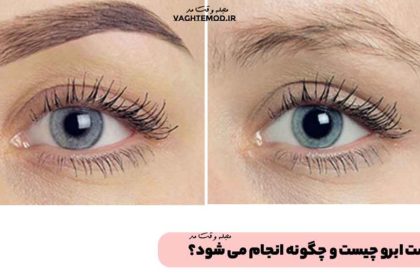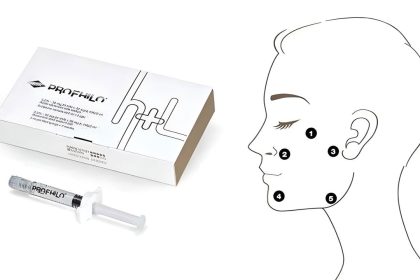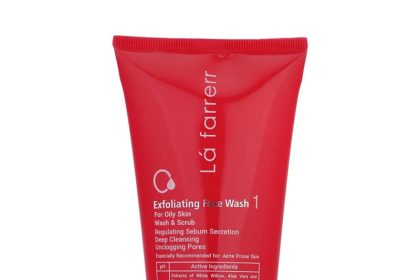There are different types of skin that are determined based on the amount of fat in the skin. It doesn’t matter what your skin type is, because everyone should have a skin routine and follow it. But what is a skin routine? The skin routine is your answer to the conditions and symptoms you receive from the skin, which will be different in all skin types. Note that the products used in the routine of oily skin and other skin types are different from each other. If you have combination or oily skin, follow this article from Miss and Mister magazine to learn about the combination and oily skin routine.
Diagnosis of oily skin
The first important question about oily skin is its accurate diagnosis. Oily skin in general has a shiny appearance, especially around the T-zone (forehead, nose, and chin). To detect oily skin, check the behavior of your skin approximately 30 minutes after cleansing. If all parts of your skin look oily, most likely, your skin type is oily.
Oily skin
Oily skin is one of the types of skin that is prone to problems such as pimples and acne. Many reasons cause the skin to become too oily, including stress, hormonal fluctuations, genetics, etc. Oily skin can clog pores and cause acne. Of course, oily skin also has benefits, for example, the possibility of skin wrinkles is reduced. An oily skin routine will help you take care of your skin health and avoid problems like pimples and acne.
Step 1: Cleanse your skin morning and night
The most important step in an oily skin routine is to take care of the skin by cleansing it. Although everyone should wash their skin in the morning and at night, this is more important for people with oily skin. Some people, when they wake up, think that their skin is clean from the night before and does not need to be washed, but this is not the case. During the night, your skin is busy shedding dead cells and producing oil. Facial cleanser for oily skin should be oil-free and contain salicylic acid.
Step 2: Use toner

After washing the skin and when the skin surface is free of any makeup, oil and pollution, use a toner. The toner you use must have one of the following ingredients:
- salicylic acid
- Glycolic acid
- Lactic acid
Using a toner, impurities and excess substances are completely removed from the surface of the skin and your skin pores are opened so that acne does not occur.
Step 3: Treat your skin
Do not ignore your skin problems and treat them. One of the most important problems of oily skin is pimples and acne. To treat these problems, see a dermatologist to prescribe medicine and products suitable for the type of skin problem you have. For example, to treat acne, benzoyl peroxide may be recommended to reduce excess skin oil.
Step 4: Moisturize the skin in the morning and at night
Some people think that using moisturizing and hydrating creams has no place in their oily skin routine; But it is not! Moisturizing the skin is one of the most important steps in the oily skin routine. Of course, people with oily skin should be careful about the type of moisturizer they use. A suitable moisturizer for oily skin has the following characteristics:
- light weight
- without oil
- Water based
These features are essential for a suitable moisturizer for oily and acne-prone skin.
Step 5: Don’t forget to use sunscreen

Protecting the skin from the sun’s ultraviolet rays is also very important. Sunscreen suitable for oily skin should be fat-free and have an SPF higher than 30. Note that even on cloudy days, it is necessary to use sunscreen. Apply sunscreen on the skin 15 minutes before leaving the house and reapply every 2 hours. In the peak hours of sunlight, i.e. from 10:00 am to 2:00 pm, in addition to sunscreen, use protective equipment such as hats and sunglasses.
Step 6: Peel off the skin
Peeling oily skin prevents the accumulation of dead skin cells and excess oil in the pores. With a proper exfoliation, the possibility of pimples and acne is reduced and the health of the skin is guaranteed. For oily skin, a chemical exfoliator should be used 1-2 times a week. Chemical peels such as alpha hydroxy acids (AHAs) and beta hydroxy acids (BAHs) are the best choice for oily skin. Note that exfoliation is the next step after cleansing and using toner.
Dos and don’ts of oily skin routine
If you have oily skin, you can control the amount of skin oil by following various tips to keep your skin free from problems such as pimples and acne.
- Wash your skin after every workout.
- Choose skin products that are labeled “oil-free” and “non-comedogenic.”
- Use mild detergents. Strong detergents dry the skin and by irritating the skin, oil is produced.
- Avoid alcohol and oil based cleansers as they irritate your skin.
- To prevent acne, your sunscreen should contain zinc oxide and titanium dioxide.
- Choose cosmetics that are oil-free and water-based.
- Before going to sleep, remove all the cosmetic products from the skin and never sleep with makeup on.
- Do not touch your face with your hands, as this will transfer the contamination from your hands to your skin.
- If you are dealing with skin problems such as pimples and acne, see a doctor to treat them.
- During the day, clean your face with blotting paper to remove excess oil. For this, don’t pull the paper on the skin, because the oil of the skin will spread, just put the paper on the skin and remove it.
Diagnosis of mixed skin

Combination skin is one of the most common skin types and most people have skin with mixed features. Before looking for a combination skin routine, you must first identify your skin type. Check the skin half an hour after cleansing. If you feel oily around the T-zone of your face, i.e. forehead, nose and chin, but other parts of the skin like cheeks are dry, you most likely have combination skin type and should follow a combination skin routine.
Combination skin routine
Combination skin is oily in some places and dry in some places, and that is why it has an oily and dry state. Having this type of skin is a genetic condition, but may change with hormonal and seasonal fluctuations. With age, the skin gradually becomes drier and loses its fat. Also, combination skin may change according to lifestyle, stress, mood and type of nutrition. In the following, we have presented a mixed skin routine in several steps.
Step 1: Clean the skin morning and night
Use a mild cleanser and wash your face with lukewarm water once in the morning and again at night. Choosing the right cleanser for your skin depends on how oily your skin is, because it may change with the seasons. If your skin is oily, look for oil-free or low-oil cleansers. Cleaning the skin in the morning prevents the accumulation of skin oils.
Step 2: Use toner morning and night
Using toner is essential for combination skin and in Korean skin routine. Look for a product that balances the skin’s pH and contains hyaluronic acid. On the one hand, this acid increases skin moisture and on the other hand, it reduces skin irritations. The use of toner is the step after cleansing the skin, which is used on the skin with a cotton pad.
Step 3: Treat skin problems
It doesn’t matter what your skin type is or what skin routine you follow, treating skin problems is always a top priority. People with combination skin may develop pimples and acne on the T-spots of their skin. To treat these problems, see a dermatologist to recommend treatment methods suitable for your skin.
Step 4: Moisturize the skin in the morning and at night

Moisturizing and hydrating the skin is one of the most important steps in the routine of mixed skin. Choose a lighter moisturizer in the morning and apply it to your skin after cleansing and toning. Use a richer moisturizer at night to help regenerate your skin cells while you sleep. Hyaluronic acid products are the best option for maintaining the moisture of combination skin.
Step 5: Apply sunscreen during the day
People with combination skin should use sunscreen to protect themselves from the sun’s harmful rays to prevent premature skin aging and wrinkles. The sunscreen used should have an SPF higher than 30 and be used 15 minutes before leaving the house. The correct use of this product is to extend the sunscreen after every 2 hours.
Step 6: Peel off the skin
Exfoliating the skin prevents pimples and acne in the T zone of combination skin. For mixed skin, you can use exfoliator 2 to 3 times a week. Of course, physical exfoliators are not recommended for combination skin because they irritate the skin. For this type of skin, chemical peels such as lactic acid are the best option, because while being gentle, they remove dead cells. Note that exfoliation is the next step after cleansing and using toner.
Combination skin routine dos and don’ts

If your skin is mixed type, in addition to the mentioned steps, consider the following points to provide the best conditions for your skin:
- Wash and clean your face after sports or other vigorous physical activities.
- Make your skin routine a habit and be sensitive to its implementation.
- Use a face mask suitable for your skin at least once a week.
- To hydrate the skin more, you can also use face oil at night after moisturizing cream.
- Use cosmetics that have a light texture. Also, foundation and concealer should be oil-free.
- Do not sleep with makeup and be sure to remove your makeup before going to sleep.
- For skin health, use vitamin C cream to neutralize free radicals on the skin surface.
- If the amount of fat in your skin changes with the change of season; In this case, change your skin products as well.
- Prioritize the treatment of your skin problems and use the advice of a specialist doctor.
- Avoid touching the oilier areas of the skin, i.e. the T zone, and do not touch your contaminated hand to the skin.
Buy products suitable for mixed skin types

In this article, we introduced the routine for oily skin and the routine for mixed skin and introduced the important points about the care of these two types of skin. As we said, to take care of any type of skin, you need to use special products. Get your desired skin products from reputable brands so that you can rest assured about their quality.
The credibility of the store is also one of the important points when buying skin products. Miss and Mr. store is one of the reliable and long-standing online stores in the field of selling all kinds of cosmetics, health care, perfumes and colognes. In this store, you can buy the best products from reputable brands at reasonable prices.
Frequently Asked Questions
How to recognize mixed skin?
30 minutes after cleansing, check the skin. If the T-spots of the skin, i.e. the forehead, nose and chin, are oily, but the other spots are dry, you probably have combination skin.
How to recognize oily skin?
After half an hour of cleaning the skin, check it. If all parts of the skin are oily, your skin type is oily. In this case, the T points of the skin (forehead, nose and chin) are more shiny.
What are the important points in the oily skin routine?
In your oily skin routine, you should use products that are “oil-free” and “non-comedogenic”. It is also necessary to clean the skin (morning and night), use toner, moisturizer, sunscreen and exfoliate 1-2 times during the week.
What are the important points in the mixed skin routine?
The amount of skin oil in people with combination skin is not the same. These people should choose their skin products according to the amount of skin oil. If skin oil changes during different seasons, the type of products should also be changed.
References:
healthline.com
healthline.com
RCO NEWS
RCO


















